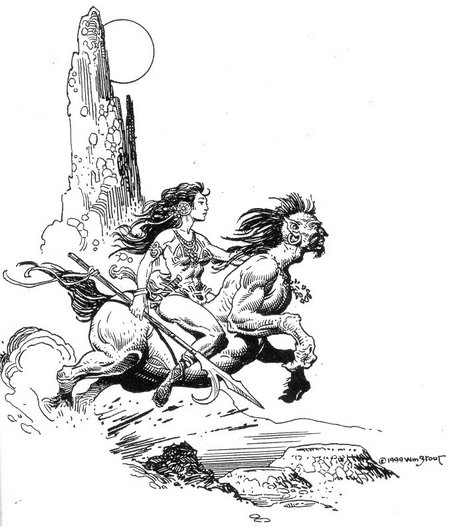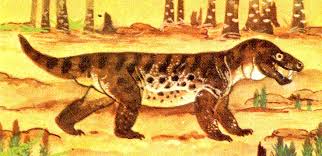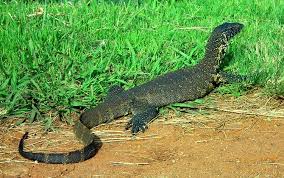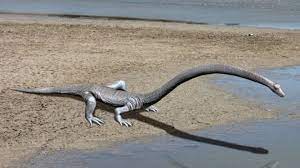A complaint often levelled at Edgar Rice Burroughs (ERB) is that the worlds he describes are ecologically unbalanced. His heroes often encounter large predators, but animals which are their more usual diet are seldom mentioned.
I feel this criticism is a little unfair. ERB's narrators are usually busy rescuing princesses, so have greater concerns than cataloguing every Barsoomian bunny or Amtorian antelope. Omission of mention cannot be taken as evidence of absence. The protestant version of the Bible never mentions cats, after all.

That said, what ERB tells us about the Va-nah in “The Moon Maid”, does strain credibility in more respects than usual.
Firstly, Va-nah is on the Earth's moon. More specifically, it is the hollow interior of the moon.
The Va-nah visited by Julian the 5th is evidently in the wake of a mass extinction that has significantly reduced the number of animal species. The reason for this extinction is never detailed. Other writers have conjectured that predation by the Va-gas and/or humans of Va-nah might have been responsible. This would seem unlikely, unless there was a significant increase in the population or the capability of these groups.
The population of intelligent life on Va-nah has also been reduced.
The technologically advanced civilization of the Jemadars had been destroyed by the Kalkar and Va-gas uprising. This is an event one would expect to lower their populations and actually favour other surviving animal populations.
Toxic Menu
To further complicate the issue, most of the species that survive the mass extinction are toxic and cannot be eaten by humans nor Va-gas:
“…there is no animal in that part of the interior lunar world with which I am familiar, that they may eat with safety. The flying-toad and the walking snake and the other reptilia are poisonous, and they dare not eat them.” (Chapter III)
As far as carnivorous diet is concerned, the intelligent life of Va-nah is on a separate food-chain. The Va-gas eat the U-ga and enemy Va-gas. U-ga eat Va-gas. They cannot eat any of the other animals of this world.
Other Animal Species
Within the text of “The Moon Maid”, ERB names only five animal species. A few reviewers seem to take this to mean these are the only animal species on Va-nah. Other creatures are, however, mentioned:
‘Jay and Orthis were positive that they discerned some form of animal life, [on the outer surface of the Moon] either insect or reptilian. These I did not see, though I did perceive many of the broad flat leaves which seemed to been partially eaten. (Chapter I)
‘The principal mortality among the [Va-gas] females results from three causes — raids by the other flesh-eating species which inhabit the inner lunar world, quarrels arising from jealousy among themselves, and death while bringing forth their young, especially during lean seasons when their warriors have been defeated in battle and have been unable to furnish them with flesh.’ (Chapter IV)
‘We already had seen evidences of life of a low order, both reptile and insect, or perhaps it would be better to describe the latter as flying reptiles, as they later proved to be — toad-like creatures with the wings of bats, that flitted among the fleshy boughs of the forest, emitting plaintive cries. Upon the ground near the ship we had seen but a single creature, though the moving grasses had assured us that there were others there aplenty. The thing that we had seen had been plainly visible to us all and may be best described as a five- foot snake with four frog-like legs, and a flat head with a single eye in the center of the forehead. Its legs were very short, and as it moved along the ground it both wriggled like a true snake and scrambled with its four short legs. We watched it to the edge of the river and saw it dive in and disappear beneath the surface.
“Silly looking beggar,” remarked Jay, “and devilish unearthly.”
“I don't know about that,” I returned. “He possessed nothing visible to us that we are not familiar with on Earth. Possibly he was assembled after a slightly different plan from any Earth creature; but aside from that he is familiar to us, even to his amphibious habits. And these flying toads, too; what of them? I see nothing particularly remarkable about them. We have just as strange forms on Earth, though nothing precisely like these.” (Chapter III)
“The flying-toad and the walking snake and the other reptilia are poisonous, and they dare not eat them.” (Chapter III)
Most of the animal life of Va-nah seems to be toxic-fleshed reptiles or reptiloids. The U-ga and Va-gas are the only mammals.
There are hints in The Moon Maid that the U-ga may have originated somewhere outside the interior of the moon. This might explain the small number of mammalian species on Va-nah and their dietary incompatibility with the other creatures in the ecology.
Most of the described animals on Va-nah are surprisingly small.
In one-sixth gravity, one would expect creatures of about three-times (x3.3) the size of Earth equivalents (GURPS Space 4e p.150).
U-ga
Like most of the worlds he describes, ERB's moon is inhabited by a human or closely humanoid people. On Va-nah, these are the U-ga.
At the time of Julian the 5th's visit the only known surviving U-ga are the population of Laythe and the Kalkars.
ERB tends to reserve the term “U-ga” for the humans of Laythe. Within the text it is explained that the Kalkars and the ancestors of the Laytheans were once the same civilization and the same people.
The following interchange with a Va-gas suggests that the term U-ga has a wider usage:
“From whence come you, U-ga?” he demanded.
Her head was high, and she eyed him with cold dignity as she replied, “From Laythe.”
This question perhaps suggests that answers other than “Kalkar” or “Laythe” may have been expected.
By the time of Julian's visit, the population of Laythe are all dark-haired and pale-skinned.
The Kalkars are less gracile than the humans from Laythe: “…They have close set eyes which are watery, fishy, and vary from blue to brown. They have hooked shaped noses. Above their low foreheads is flaxen hair that varies from light blonde to black. They walk with a noticeable stoop, and their large feet gives them an awkward gait.”
“The Burroughs Bestiary” by David Day claims that the Kalkars have blue skin. I find no evidence for this claim in the original text. Julian notes: “…with my relatively darker skin and my blond hair, I could never hope to be aught than an object of remark in any Laythean company. Owing to the color of my hair, some of them thought that I was a Kalkar, but upon this score my complexion set them right.”
Moh-goh and Julian disguise themselves as a Kalkars, so they are definitely not blue-skinned!
How much like Earth humans are the U-ga?
Nah-ee-lah adapts to life on Earth well enough to give birth to the next generation of Julians.
The Kalkars that invade Earth are also evidently close enough to Earth-born humans to interbreed. By the 25th century most Kalkars had some Earth blood in their ancestry. Bethelda has large green-gray eyes and it is some time before Julian the 20th realizes that she is a Kalkar.
“There is a great variety of physiognomy among them, for they are a half-caste race, being the result of hundreds of years of inter-breeding between the original moon men and the women of the earth whom they seized for slaves when they overran and conquered the world. Among them there is occasionally an individual who might pass anywhere for a Yank, insofar as external appearances are concerned; but the low, coarse, brutal features of the Kalkar preponderate.” (The Red Hawk, Chapter IV)
We are also told:
“He was a large man as most Kalkars are, for they have bred with that alone in mind for five hundred years [on Earth], so that many of them are seven feet in height and over.” (The Red Hawk, Chapter III)
Possibly the most remarkable thing about the U-ga on Va-nah is that they so closely resemble Earth humans, given that they spend their lives living in one-sixth of the gravity. Of course, ERB's stories are essentially romances, and these might lose something if the leading lady is seventeen feet tall with slender limbs like a daddy-long-legs!

Va-gas
The Va-gas are one of ERB's more intriguing creations. Sadly he does not give us the depth of detail that he provides in some of his other stories.
The Va-gas are often incorrectly portrayed as centaurs. This is another error in the “Burroughs Bestiary”, which not only describes them as centaurs, but provides an illustration as such, complete with eagle feather ornamentation! No birds in Va-nah, and no mention of feathered reptiles!
The Va-gas are in fact quadrupeds. and have only four limbs. They walk on all fours, but can rise up on their hind legs to fight or should they have another use for their forepaws.
This article likens the Va-gas approach to locomotion to that of bears, which is very conductive to understanding. Baboons may be a more appropriate analogue.
Unlike a terrestrial bear, the Va-gas can run for extended periods of time, and in the lunar gravity may cover up to 300 feet in a bound.
A male Va-gas is around the size of a small pony, we are told. The glossary here gives a weight of 250-300 lbs, but it is not clear if this figure allows for the reduced lunar gravity. 300 lbs would be light for a pony on Earth, but is much greater than one would expect a small pony to weigh in one-sixth gravity.
In several places we are told that Va-gas leave three-toed tracks. During close combat, Julian described Va-gas inflicting injuries with teeth, daggers and three-toed paws.
Are the Va-gas plantigrade, digitigrade and unguligrade? Does this change with bipedal or quadripedal mode?
Julian the 5th is not the most scientific of observers, which makes me wonder if the paws of the Va-gas have additional digits that do not touch the ground and leave an imprint. A thumb and two fingers of equal lengths would seem to suggest a clumsy form of forepaw. We know that Va-gas leatherwork is fancifully decorated, which suggests a reasonably good level of dexterity.
A three-fingered forepaw with an opposable thumb in the position of a dewclaw seems more credible. Such a forepaw may or may not have a vestigial little finger.
Va-gas apparently have lavender-hued skin. ERB does not introduce this fact until he observes that a Va-gas chieftain “was a large male whose skin was of so much deeper lavender hue than the others that we had seen, as to almost suggest a purple.” Incidentally, the plant life of Va-nah is in pale hues of lavenders, violets, pinks, and yellows, suggesting the skin colour of the Va-gas may have a camouflaging role. This raises the question what form of predator or threat may have selected for this trait.
Both the Kalkars and the Laytheans breed and fatten Va-gas for food. Kalkar leather tunics are made from Va-gas hide.
Julian sees Laythean hunters, and if they are hunting for meat they logically can only be hunting Va-gas.
The Laytheans selectively breed their Va-gas for stupidity and lack of imagination, so that their Va-gas are contented and oblivious to their purpose and fate. These are the Homer Simpson/sheeple of Va-nah. These domesticated Va-gas probably constitute a breed distinct from their nomadic relatives.
Nah-ee-lah considers the Va-gas to be a different species to the U-ga. This seems to be the commonly held belief on Va-nah. This may possibly be a convenient cultural fiction to avoid an uncomfortable truth.
Given the similarities between Va-gas and humans, and that the U-ga once enjoyed a technologically more advanced civilization, the possibility exists that the Va-gas may in actuality be a deliberately modified strain of human/U-ga intended as beasts of burden and labourers.
At the start of the book “The Moon Men”, we are informed that the force that invades Earth includes a thousand Va-gas. Sadly, no further mention is made of them, so the fate of the Va-gas on Earth, and how they fare on a new world is unknown.
No information is given as to how the nomadic Va-gas are affected by the new weapons Ortis provides for the Kalkar population that remains on the moon.
Tor-Ho
Unusually for ERB, Va-nah has only one predator that is dangerous to humans or Va-gas. This creature is rare and seldom encountered, but very aggressive.
“We know of no other dangerous beast, except the Tor Ho. They are seldom seen.” (Chapter VII)
The above statement contradicts the reference to “raids by other flesh-eating species” made in Chapter III.
The tor-ho is about the size of a mountain lion, and has “something about the head and face which suggested the cat family”. It stood between eighteen inches and two feet in height, had long, sharp fangs, four legs and was hairless.

The tor-ho is clearly described as a reptile. It most likely resembles a large monitor lizard or small komodo dragon.
Its claws and fangs are poisonous, which is attributed to its diet mainly consisting of the poisonous flesh of flying toads and rympth. Like other reptiles on Va-nah, the tor-ho itself is poisonous to eat for humans and Va-gas.
The tor-ho, however, clearly regards Va-gas and humans as palatable and edible prey.
This article in ERBzine suggests that the tor-ho and other reptiles are “sprawlers”. One-sixth gravity would make this mode less of a hinderance than it is for terrestrial reptiles.
Other than its aggression and poison, the tor-ho is rather modest compared to the predators in other stories by Burroughs.
The creature the tor-ho most reminds me of is the prehistoric Cynognathus. In previous decades Cynognathus was often portrayed as a dog-like reptile. Perhaps the tor-ho can be thought of as a shorter-snouted Cynognathus, hence its cat-like quality?
Flying Toads
The flying toads have a somewhat ambiguous introduction:
‘We already had seen evidences of life of a low order, both reptile and insect, or perhaps it would be better to describe the latter as flying reptiles, as they later proved to be – toad like creatures with the wings of bats, that flitted among the fleshy boughs of the forest, emitting plaintive cries.’
Julian initially seems to mistake the flying toads for flying insects. This calls into doubt whether there are any actual insectoid creatures in Va-nah. It also creates the possibility that the insects that Jay and Ortis believed they observed on the outer surface of the moon may actually be the local equivalent of flying toads. Possibly some flying toads have adapted to life on the outer surface after they have travelled to the exterior via the hoos.
It is quite possible that the hoos let flying creatures from the exterior visit the interior and vice versa. Some creatures may be common to both surfaces, or routinely migrate between the two.
Julian also considers the flying toads to be reptiles rather than amphibians. Julian the 5th does not tell us if the flying toads appear to be a single species, or if he is using the term for a large variety of similar creatures.
We are told little more about the flying toads, other than that their flesh is poisonous for Va-gas and humans to eat.
What do the flying toads eat? It is possible that they could be herbivorous, of course. Being described as toad-like does imply a broad mouth. Broad mouths are well suited to quickly gulping down smaller creatures.
Related to this is why do flying toads fly? Even under one-sixth lunar gravity, flight is metabolically demanding. The ability to fly tends to be lost unless it continues to offer some advantage, such as escaping predators or reaching food-sources.
If flying toads fly, there is probably something that eats flying toads. We are told the tor-ho eats flying toads, but also this a fairly rare creature and presumably in low numbers. There must be, or have recently existed, other predators from which the flying toads are attempting to escape.
There may be something that flying toads fly after to eat. While this does not prove there is insect(-oid) life on Va-nah, it does strongly suggest there are smaller flying creatures for the flying toads to prey on.
Rympth
‘A five foot snake with four frog like legs and a flat head with a single eye in the centre of the forehead. Its legs were very short, and as it moved along the ground it both wriggled like a true snake and scrambled with its four short legs. We watched it to the edge of the river and saw it dive in and disappear beneath the surface.’
The rympth seems a fairly inoffensive and innocuous creature, yet on Va-nah is regarded as the lowest and most disgusting of created things.
We are not told if the rympth is a single species, or if the term applies to a variety of related or similar forms.
Mass extinctions often result in the surviving species diversifying to exploit newly vacant ecological niches. It is reasonable to expect there to be several species of rympths and of flying toads.
Wriggling like a snake and scrambling with four short legs is reminiscent of the terrestrial skinks, a large and successful group of reptiles. Snakes themselves are very successful, which raises the question as to why a creature needs legs when it has a snake-like body?
One answer may be speed. In one-sixth gravity relatively small pairs of legs may be able to raise the rympth's belly off the ground, allowing faster movement. Simultaneously the body might be coiling-down to push against the ground for additional thrust.
Perhaps the legs have an additional function.
If the feet are equipped with claws and/or suction pads they might aid the rympth in climbing. Possibly the forelegs are useful when swimming or burrowing?
We are not told how the rympth's legs are configured, and this may vary with species.
The forelegs may be positioned quite close to the head, where they can assist in feeding and cleaning. It is tempting to imagine the rear legs at the very end of the creature. This is effectively a greatly elongated frog. The legs would be too far apart to keep the belly off the ground, hence the need for additional serpentine motion.

Alternately, and more conventionally, the hind legs may be further up the body, making a portion of the creature's length a tail. A rympth of this configuration would resemble an elongated version of an Earth skink.

If the forelegs are positioned further back, we have a longer-necked creature that would probably resemble a slim-bodied monitor lizard. The monitor lizards of Earth are another highly successful reptile group, so a rympth variant resembling them might be expected to fare well on Va-nah.
One can imagine a rympth with an even longer neck. For example, the forelegs may be about a yard behind the head, and the hind legs a foot or so behind these. Such a rympth has a three-foot long neck, a foot-long body and a foot-long tail.

This configuration gives us a creature resembling a very skinny Tanystropheus. The neck section would outweigh the body and tail, so the creature would have to keep its neck close to the ground and employ serpentine motion to supplement its legs.
It will be noted that in the above I have kept true to the statement that a rympth is five feet long. Julian only described a single rympth in detail. We do not know if this individual is typical or if it is fully grown. Size range of different rympths may vary considerably.
What do rympths eat? We are not told. My suggestion for a very long-necked rympth assumes flying toads and other flyers are on the menu.
One of the possible niches for the long-necked rympth is as an arboreal hunter. Serpentine bodies are good for climbing trees. Once the rympth reaches a branch it likes, it grips it with its legs to anchor itself. Its long neck can then explore the local area for food. The neck can also coil and strike-out at tree-dwelling or flying animal life. A rympth on a low branch may stake-out a game trail or stream.
The rympth Julian observes takes to the water, suggesting it is a competent swimmer. A snake-style body-form is good for swimming, so some rympth may prey on Va-nah's equivalent of fish, amphibians and aquatic invertebrates.
It is also possible that some rympth fill a niche similar to that of a crocodile, ambushing animals that come to drink at the water's edge.